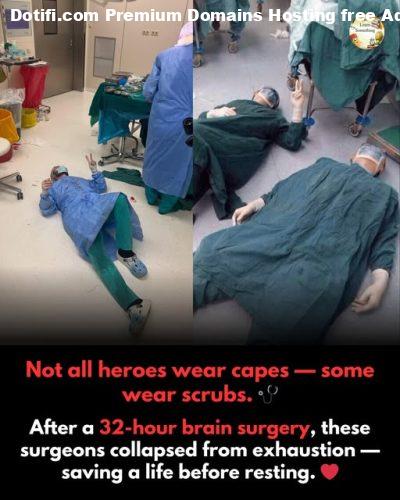The Event — what we do know
In June 2014 (and widely reported later) at Fujian Medical University Union Hospital in Fuzhou, China, a team of three surgeons, six anesthesiologists and eight nurses performed a marathon neurosurgical operation lasting approximately 32 hours. China Daily+2archive.shine.cn+2
-
The patient was reported to have multiple brain tumours (including a brain-stem hemangioblastoma) and an aneurysm, and the team performed six major/minor operations in one sitting to treat the case. archive.shine.cn+2sunnyskyz.com+2
-
At the end of the surgery, images circulated on Chinese social media showing exhausted surgeons lying on the operating-room floor, still in scrubs, having collapsed from exhaustion. China Daily+1
-
The surgery was described as a record-setting operation for that hospital. archive.shine.cn
What we do not fully know / what the viral message gets wrong
-
The viral version names the surgeons as “Dr Dai” and “Dr Tian”. I found no credible source that mentions these names in relation to this case. The published reports identify one lead surgeon as Chen Jianping. China Daily+1
-
The viral text suggests “two surgeons” collapsed. The accepted reports say “three surgeons” in the team. China.org.cn+1
-
The story frames the procedure as a single aneurysm repair, whereas the medical reporting states multiple tumours plus an aneurysm, six procedures in one sitting. sunnyskyz.com+1
-
Some emotional elements (“cold operating room floor”, “spent over a full day”, “no matter the cost”) are embellishments rather than direct factual quotes from sources.
So: the core story is true — long surgery, team collapsed from exhaustion, image went viral. But some details in the viral version are either inaccurate or unverified.
Reflecting on the bigger issues
This case raises important questions—not only about the heroism of doctors, but about the risks, the systems, and the human factors involved in extremely long, high-stakes surgeries. Here are three key questions we should ask, followed by some reflections.



1. Why do doctors perform such ultra-long surgeries despite the danger of fatigue and error?
-
In neurosurgery especially, some complex cases pose a “window of opportunity” or a “one-chance” scenario: the tumour (or aneurysm) is in a critical location, delaying could increase risk of rupture, bleed, neurological damage, death. In the reported case the team said the two lesions needed to be removed in one session because if one ruptured later the outcome could have been fatal. sunnyskyz.com+1
-
There may be institutional or cultural pressures: complex cases bring prestige; the hospital may have few peers able to perform the task; the surgeon team may feel morally compelled to carry on until completion rather than hand off.
-
Surgeons are trained for endurance, and share a mindset of sacrifice. In the Chinese news report, the surgeon said: “It isn’t only me who works so hard to treat patients — so many surgeons just like me, who are not seen.” China Daily
-
But fatigue is a real risk. When a surgeon is exhausted, performance may degrade: slower reaction times, impaired pattern-recognition, reduced ability to cope with unexpected complications.
2. Given human fallibility under stress and fatigue, why not bring more surgeons or rotate teams so no one is operating for 32 hours straight?
-
Ideally, yes — rotating teams is safer. But practical constraints sometimes limit that: not all surgeons may have the required specialised skill for that case; the logistics of handing over mid-procedure might increase risk if continuity suffers; each hand-off adds a moment of vulnerability.
-
Also, hospitals may lack sufficient specialists or resources to split a case into multiple shifts, especially in high-complexity operations that are relatively rare.
-
There might also be mindset issues: the lead team may believe that continuity (same team from start to end) offers better outcomes for technically challenging surgery than multiple shifts.
-
Nonetheless, from a human-factors perspective, the longer a person operates without rest, the higher the risk of error. The surgery in Fujian appears to be exceptional rather than standard, but it raises the question of institutional safeguards: was the hospital’s scheduling, support, rest breaks adequate?
3. What does this tell us about healthcare systems, surgeon wellbeing, and patient safety?
-
The episode highlights the commitment of individual doctors: foregoing sleep, working exhausted, to save a life. That is admirable.
-
But systems should not rely solely on individual heroism. A healthcare system that expects doctors to push past fatigue may be flirting with preventable risk.
-
Surgeon wellbeing matters: burnout, long hours, sleep deprivation increase risk of mistakes, complications, and long-term health issues for the physician.

-
For patients and public trust: knowing that a surgeon has been operating 30+ hours may raise concern about safety. Transparency and institutional safeguards are important.
-
It suggests that recognising surgeons as “heroes” is valid—but the hero narrative should not excuse structural issues like understaffing, fatigue risk, poor scheduling. The best tribute to their dedication is to build better systems, not rely on breakdowns.
Conclusion
The photograph from Fujian of exhausted surgeons on the floor after a marathon 32-hour neurosurgery is real and impactful. It captures dedication. But it also functions as a prompt for deeper reflection: why did the surgery run so long, how did fatigue-risk get managed, and what does this mean for patient safety and doctor wellbeing?
When people make mistakes under stress, we hold systems responsible: in aviation, we regulate pilot fatigue; in nuclear plants we impose strict hand-offs. So when doctors perform under extreme fatigue, we ought to ask: are the systems optimised, or are we relying on human endurance at cost?